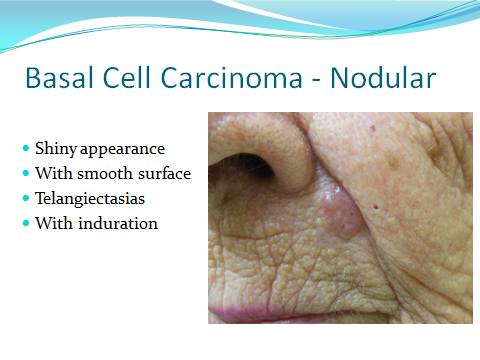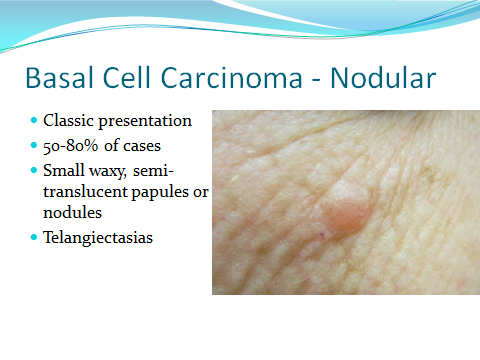Welcome to the DermacenterMD Blog
Posts for tag: Mohs surgery


Basal cell carcinoma is not an uncommon cancer to occur on the lip. The lips are often overlooked when looking for non-melanoma skin cancers. However, given their highly visible location, the majority of lip cancers are easily detectable and treatable at an early stage. A raised pink or pearly bump on or around the lip can be a possible sign of skin cancer.
Cancer of the lips comprises approximately 0.6 percent of all cancers in the U.S. It is the most common malignant lesion of the oral cavity, constituting 25-30 percent of all oral cavity cancer cases. Studies have shown that males are 3-13 times more likely to develop lip cancers, likely due to occupation-related sun exposure combined with greater alcohol and tobacco use. The lower lip is approximately 12 times more likely to be affected, because it often incurs more sun exposure.
The best treatment in delicate areas like this is done with Mohs Micrographic Surgery. With Mohs surgery, less tissue is taken, and therefore there is usually less scarring. This form of treatment also offers up to a 99% cure rate, making it the most effective treatment available for basal cell carcinoma.
.jpg)
Be on the lookout for skin cancer! 1 in 3 people are estimated to have skin cancer in their lifetime. It can affect anyone at any age and with any skin type. You can never be too careful or too cautious. Taking care of your skin, like always remembering your sunscreen, and being educated about skin cancer are great ways to protect yourself and those you love.
Below are five different skin conditions to keep an eye out for when you exam you skin, as well as a short story that demonstrates the importance of knowing what to look for and being diligent in getting in to see your dermatologist for regular skin checks.
Different Types of Skin Cancer:
Basal Cell Carcinoma (BCC)
The most common cancer diagnosed in the U.S. These present as raised, pink, translucent, pearly nodules that may ulcerate and bleed. These can be found on sun exposed sites, but not always.
Squamous Cell Carcinoma (SCC)
Usually raised, pink nodules or patches that occur on sun exposed sites. These often occur with no symptoms and a small number can become invasive.
Melanoma
This cancer can become invasive and life threatening. Most are brown to black with irregular borders, but not always.
Be alert for the ABCDE’s:
Asymmetry
Border irregularity
Color variation
Diameter (larger than a pencil eraser)
Evolving or changing
Actinic Keratosis (AK)
These pre-cancers are caused by the sun and are often rough scaly bumps. Most occur on sun exposed sites and do have some risk for developing into SCCs.
Seborrheic Keratosis
These waxy tan to brown raised lesions are very common and benign. DermacenterMD considers these proof of wisdom since most occur as you become more fruitful and wise ( a.k.a. age).
That little pink spot was important?
A nice woman who lived downtown and liked to play bingo came in because a friend told her to get a red scaling rash on the left temple checked out. It had been there two months and she had tried several over the counter creams, including hydrocortisone and anti-fungus cream, but it would not go away completely. The spot never had bleeding or pain.
It was suspicious, so a small sample of skin was taken to be sent off to the lab, a procedure termed a biopsy. Most often the biopsies have minimal discomfort and can yield important information as in her case. The spot turned out to be a basal cell cancer. Yes, that little rash was a skin canÂcer. She is an example of why we need to 1) educate ourselves on what to look out for and 2) get regular dermatology skin examinations.
Basal cell and squamous cell carcinoma are the most common skin canÂcers and they can be treated easily if caught early. Dr. Moore specializes in a scar minimizing, low downtime treatment called Mohs Micrographic Surgery. This technique also provides the highest cure rate available. If you suspect cancer, call now to get your peace of mind and safety.
Our office can be reached at 574-522-0265.
Archive:
Tags
- dry skin (2)
- moisturizer (1)
- sensitive skin (3)
- PA (2)
- Skincare (2)
- skin cancer (29)
- cancer (6)
- facts (1)
- skin (19)
- dermatology (22)
- skin care (19)
- cosmetic (2)
- wrinkles (1)
- Botox (4)
- Dysport (3)
- sleep (1)
- look good (1)
- daily routine (1)
- healthy lifestyle (1)
- doctor (2)
- patient (1)
- sun protection (5)
- sunscreen (14)
- aging dermatology (1)
- providers (1)
- tanning (2)
- sun (6)
- UVA rays (2)
- UVB rays (2)
- melanoma (10)
- Acne (2)
- Treatment (2)
- sunscren (1)
- sun exposure (5)
- Melanoma Monday (2)
- Skin Cancer Awareness Month (1)
- education (2)
- skin cancer specialist (1)
- basal cell carcinoma (1)
- squamous cell carcinoma (1)
- ingredients (2)
- improve your smile (1)
- cosmetics (1)
- laser (1)
- fillers (2)
- sunburn (3)
- avoid the sun (1)
- hat (1)
- sun clothing (1)
- SPF (1)
- Rosacea (3)
- NP (1)
- Nurse Practitioner (1)
- mid-level provider (1)
- physician (1)
- dermatologist (6)
- cosmetic dermatology (4)
- anti-aging (2)
- youthful looks (1)
- Eczema (2)
- rash (2)
- itch (1)
- the rash that itches (1)
- reduce itch (1)
- itching (1)
- getting along with others (1)
- basal cell (2)
- squamous cell (2)
- detection (1)
- Mohs surgery (2)
- photoaging (1)
- Inspiring (1)
- word of the day (1)
- inspiration (3)
- uplifting (1)
- protection (4)
- lips (1)
- reduce wrinkles (1)
- look younger (1)
- encouragement (1)
- never give up (1)
- you can do it (1)
- medical school (1)
- dreams (1)
- brown spots (1)
- moles (2)
- liver spots (1)
- age spots (1)
- Abe Lincoln (1)
- life lessons (1)
- lip cancer (1)
- health (12)
- motivation (1)
- work (1)
- people (2)
- home life (1)
- lifestyle (1)
- ABCDEs of Melanoma (1)
- mole (1)
- skin check (2)
- skin facts (2)
- odd (1)
- fun (1)
- interesting (1)
- lung cancer (1)
- disease (1)
- Christmas (2)
- gifts (1)
- sun burn (1)
- winter skin tips (1)
- itchy skin (1)
- winter skin (1)
- myths (1)
- myth busted (1)
- skin protection (1)
- sunscreen safety (1)
- specialist (1)
- red skin (1)
- irritation (1)
- feel good (1)
- helping (1)
- help (1)
- helping others (1)
- treatment options (1)
- skin health (9)
- Vitamin D (2)
- tanning beds (1)
- skin health. dermatology (1)
- sunshine (1)
- awareness (1)
- prevention (1)
- sun damage (3)
- connections (1)
- working together (1)
- health care (1)
- biotin (1)
- medical (1)
- aging (1)
- elkhart (1)
- Roger Moore (1)
- check (1)
- skin type (1)
- skin cancer prevention (1)
- gift guide (1)
- Christmas gift guide (1)
- Dr. Roger Moore (1)
- holidays (1)
- family history (1)
